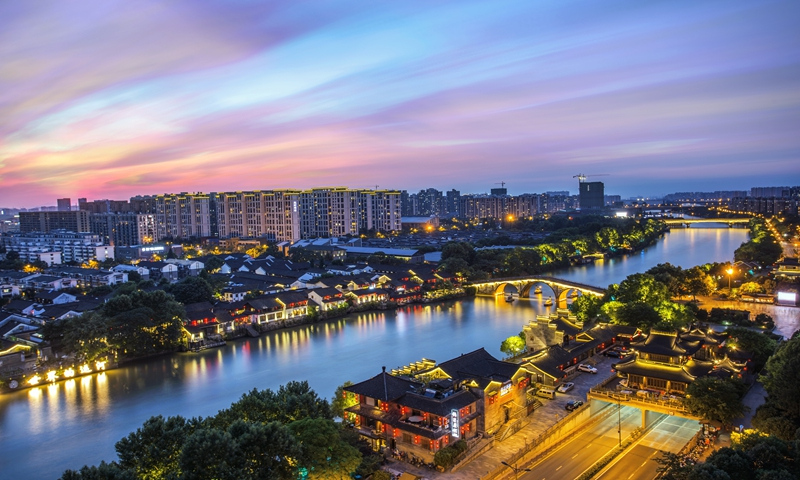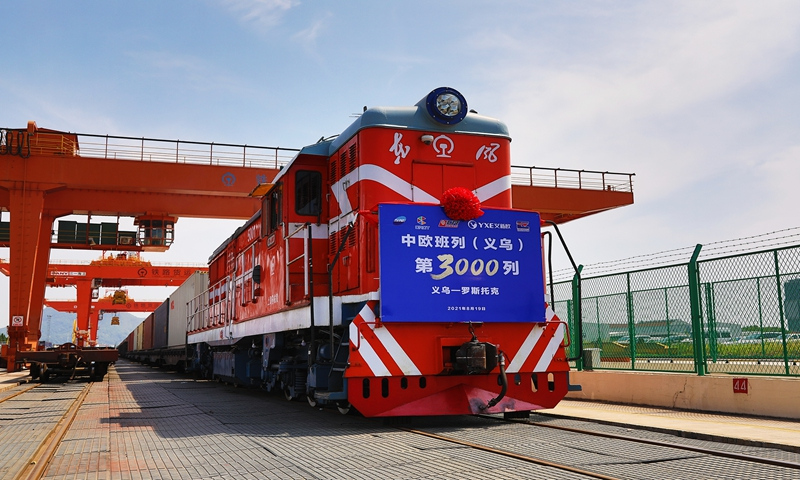
An aerial photo of Hangzhou, capital city of East China's Zhejiang Province (Photo/VCG)
In the international trade market located in Yiwu, a county-level city in East China's Zhejiang Province, you will find tens of thousands of tight, 20-square-meter shops clustered like honeycomb cells in a beehive. Upon entering any of the shops, a plainly dressed shop owner might greet you in English. It might not show, but he or she might be a millionaire or even a billionaire.
Then you take a ride on one of several highways to a village in the nearby Dongyang. There, rows of villas stand out. Farmers grow vegetables using remote control computer systems; children play in the amusement parks, and couples watch musical fountains or water screen movies. This is not a rare sight in Zhejiang but a ubiquitous one in tens of thousands of rural villages across the province.

An agricultural drone sprays pesticides at a farm in Zhoushan, East China's Zhejiang Province in August 2021. (Photo/CNS photo)
Afterward, you might take a trip to the provincial capital of Hangzhou, which is like a trip to the future. At the Hangzhou Future Sci-tech city, self-driving cars shuttle back and forth on the streets, drones fly in the sky, and streets are dotted with numerous skyscrapers, industrial parks, and laboratories.
A brief trip around Zhejiang offers not only the most vivid picture of China's economic miracle over the past four decades or so - but also a glimpse into where China is headed in the years and decades to come.
After declaring the completion of building a moderately prosperous society in all respects at the centenary of the Communist Party of China (CPC) on July 1, Chinese President Xi Jinping, also general secretary of the CPC Central Committee, announced that "we are now marching in confident strides toward the second centenary goal of building China into a great modern socialist country in all respects."
Chief among the developmental targets under the second centenary goal is achieving common prosperity for all, which has profound implications from economic development to people's living standards, to social fairness and justice. And among the dozens of Chinese provinces, Zhejiang has been picked as ground zero in the country's pursuit of that target.
In a governmental guideline released earlier, China called for Zhejiang to raise its per capita GDP to the standard of moderately developed economies by the year 2025. It also instructed that Zhejiang should form an "olive-shaped social structure" in which middle-income households are the mainstay of the economy while striving to reduce disparities between rural-urban income and living standards.
As China gropes its way toward becoming richer and more evenly affluent, it's meaningful to explore the secrets behind Zhejiang's success. Why was it picked? How did the residents make it? And what can other parts of China learn from them?
Why Zhejiang?
The Miaojia village, a seven square kilometer village located in Zhejiang's Jiashan county, has gotten a trendier name - China's chocolate town. There, tourists come from all over China to visit woods full of South American coco trees, or taste chocolate churned out by a castle-like chocolate factory. It's like a scene from the Hollywood movie Charlie and the Chocolate Factory.

Pupils visit the chocolate town at Miaojia village, East China's Zhejiang Province. (Photo/VCG)
However, about 10 years ago, the town was just deserted farmland, with some nursery gardens and wild fishing pools, Mo Xuefeng, founder of the chocolate town said.
In recent years, the building of the factory, which produces 20,000 tons of chocolate yearly, along with surrounding tourism facilities has largely changed the living standards of local villagers. Currently, 60 percent of the chocolate town's employees are local villagers.
"In the past, local villagers could only make a living through farming, but now they have multiple channels of income," said Zhi Huijun, a villager at Miaojia Village and also an employee at the chocolate town. "In our family, for example, two houses are rented to tourists. My grandma now also receives 2,500 yuan ($385.8) of pension each month, and my family might earn about 300,000 yuan each year."
In her observation, villagers like her have mostly grown richer over the years. Many families have one or two cars and have moved into commercial buildings with much better facilities and larger neighborhoods.
As the village's business thrives, there's also increased governmental input in local infrastructure, said Mo. "When I was young, I would feel surprised and excited at the sight of a new street. Now, the villages are not like traditional 'villages' anymore, with beautiful houses, many bus lines, thriving restaurants, and banks," he said.
Miaojia village's road to wealth is not an isolated example in Zhejiang. The Garden village in Dongyang, 200 kilometers away, is also known for its affluence. In 2020, each resident in the village, which thrives on redwood and vitamin sales, earned 135,000 yuan on average, higher than what some white-collar workers might earn annually in large metropolises like Shanghai and Beijing.
Martina Gdovinova, a Slovakian who has lived in Hangzhou for four years, was also in awe at what she saw at the Garden village during a recent visit.
"Everyone in the village lives in beautiful houses and drives beautiful cars... which only the richest percentage of my country's population can enjoy," she said. "From what I see, Zhejiang can be compared to the most developed countries in Europe such as Switzerland and Austria in terms of prosperity."
The two above-mentioned cases are a reflection of Zhejiang's economic strength which makes it a model for other Chinese regions. In 2020, Zhejiang's GDP aggregate reached 6.46 trillion yuan, 6.4 percent of China's total GDP and similar to the economic output of Holland.

The Ningbo-Zhoushan Port in East China's Zhejiang Province (Photo/VCG)
Zhejiang's GDP per capita in 2020 - 100,620 yuan - is 1.38 times that of China's national level and is close to the level of Poland. The richest region in Zhejiang, Hangzhou's Binjiang District, saw its GDP per capita of 406,173 yuan last year, surpassing the level of Singapore, Australia, Sweden, and Denmark.
And beyond the region's economic miracle is another miracle of how "evenly wealthy" Zhejiang has grown to be. In 2020, Zhejiang's rural residents' average disposable income was 31,930 yuan, the highest among all domestic provinces for the 36th year. Zhejiang's urban-rural income ratio reached 1.96:1, shrinking for eight years consecutively and one of the lowest levels among Chinese provinces.
Experts noted that Zhejiang only has a mediocre level in terms of geographic and natural resource advantages, which makes it a better role model than places like Shanghai and Guangzhou for most Chinese provinces to learn from.
"Zhejiang's progress seems very quiet but surprises people when they get to know it. It has never waited for policies or depended upon anyone, but has achieved prosperity gradually using its own methods, and the results are truly amazing," Zeng Gang, dean of the urban development institute under the East China Normal University and a consultant for the Zhejiang provincial government said.
According to economists, a blend of an entrepreneurial spirit and accommodative policies in Zhejiang has offered some insight into how China's regions with less natural resources can develop their own industries.
"The local governments in Zhejiang have a service mindset, in that they focus their efforts on enhancing the business environment instead of giving specific directions to businesses, such as ordering them to do certain projects or launch certain products," Chen Liu, deputy dean of the Yangtze Industrial Economic Think Tank said.
Zeng said that no other provinces in China have encouraged private business at such an early stage as did Zhejiang. "The local governments in Zhejiang are very lenient toward new business models. Private lending in Wenzhou, for example, has thrived under government tolerance, and this model is a big accelerator behind the rise of local private companies," he said.
Besides, Zeng also stressed that Zhejiang's input in technological innovations illustrates the development direction of Chinese cities.
"Science-backed development is not only rapid but also the most competitive model amid the rise of manufacturing industries in Southeast Asian countries. Zhejiang has already set an example for not clinging to the old business models, but is looking to the future," he said.

The China-Europe rail freight (Photo/VCG)
What's next for Zhejiang?
On August 17, Chinese President Xi Jinping stressed during a meeting of the Central Committee for Financial and Economic Affairs that common prosperity is an essential requirement of socialism and a key feature of Chinese-style modernization, and that common prosperity should be a pursuit amid high-quality development.
Zhejiang launched a document in June detailing the specific plans to develop itself into a common prosperity pilot zone. In the document, Zhejiang set a number of economic targets, such as raising its per capita disposable income to 75,000 yuan by 2025, lowering its urban-rural income ratio lower than 1.9:1, while 80 percent of the province's households should have an annual disposable income standing between 100,000-500,000 yuan.
It also stressed a number of reforms that Zhejiang would carry out later, including rural land reforms, a plan to let resident' income double in 10 years, and train 100,000 rural entrepreneurs, as well as push a number of scientific plans with a special focus on the Internet plus, life science, and new materials.
Several experts have told that rural land reforms should be a focus of Zhejiang's work in the coming months after the Zhejiang document mentioned that local governments should push the marketization of rural collectively operated construction land.
"The mention of rural land marketization in the document is a government nod to rural land trading. And with such government consent, the market values of rural land, whether it be for opening shopping malls, markets, or other purposes, will be explored to a greater extent by means of land reforms," Zeng said.
Wang Zhengxin, dean of the School of Economics under the Zhejiang University of Finance & Economics said that implementing a new wave of rural reforms, which can push low-income groups to make more money, is key to further narrowing of the region's rural-urban income gap.
"Besides, if Zhejiang could forcefully push upgrading of its traditional industries and strengthen its strategic emerging & future industries, the goals it set in the common prosperity plan like per capita GDP and income could be achieved smoothly," he said.
Hu Qimu, the chief research fellow at the Sinosteel Economic Research Institute, also predicted that Zhejiang might take pilot reforms on taxes, such as taxation on house property in the coming years, while the government would invest more in education and healthcare facilities.
So far, the Zhejiang provincial government has already designated 28 localities across the province to carry out such pilot programs in six areas. Hangzhou and Yiwu For example, have been tasked with narrowing urban-rural gaps, while Ningbo will be responsible for delivering high-standard public services that would be shared by all.

View of Chinese people's daily lives (Photo/VCG)
National standards
Experts also praised China's striving for common prosperity as having tremendous significance for the whole world, as not only could it play a vital role in fueling a post-COVID-19 economic rebound, but can also provide a set of experiences for foreign countries on how to stimulate the economy without triggering social discord or exploiting other countries' resources.
"Common prosperity is one of the important development goals pursued by mankind, as it can not only enhance people's buying capabilities by enlarging markets but can also help eliminate wars and chaos by reducing cases of poverty," Zeng said.
In the eyes of Hu, enhancing the income of poor people is the most efficient method to release consumption power, which would in turn drive up the economy. "In this sense, it is a key solution to driving an economic rebound after the coronavirus disease outbreak," he noted.
Some foreigners also observed that China's common prosperity pursuit could teach a lesson to foreign countries. Martina Gdovinova, for example, said that in terms of poor people benefiting from social welfare, China has surpassed many developed countries like the US, as many overseas students have to borrow money to go to schools. Therefore, the methods taken by Zhejiang to achieve commonwealth can be an example for not only Chinese provinces but for many overseas countries as well.
"In Western countries, everyone will tell you that you can't share the wealth among all citizens. The only solution for Western people is capitalism, which makes only a small percentage of people very wealthy. But suddenly here in China, I found proof that it actually works," Lucy Cao Yeman, a Slovakian who now lives in Hangzhou said.

Residents in a night market in East China's Zhejiang Province (Photo/VCG)
When talking about the feasibility of the whole of China achieving a common prosperity goal, many economists said that most Chinese cities are still far away from this level, but they have confidence that China will hit the goal with its systematic advances.
"China's economic scale has reached a scale that can be required of a higher quality, as reflected in the common prosperity strategy," Zeng said. He predicted that by the end of 2025, about one third of China's provinces should reach the common prosperity level that Zhejiang has now.
Chen Liu noted that common prosperity is not necessarily decided by economic indicators like per capita disposable income because of the disparities in domestic provinces. What's more important is that Chinese cities should achieve general evenness in public services and people's living standards. Specifically, people's per capita income growth should not be less than GDP growth, he noted.
Experts have also given some suggestions to domestic local governments on how to push common prosperity, including designing development routes based on the region's specific industries, as well as finding out what the region could provide for the global economy, just like Zhejiang's supply of small commodities for overseas markets.
"As China's government management system enables efficient systematic reforms, and policy design, it would help the country achieve its common prosperity goal as a whole," Xi Junyang, a professor at the Shanghai University of Finance and Economics said.

Goals of Zhejiang demonstration zone for common prosperity
Editor: Ye Ke